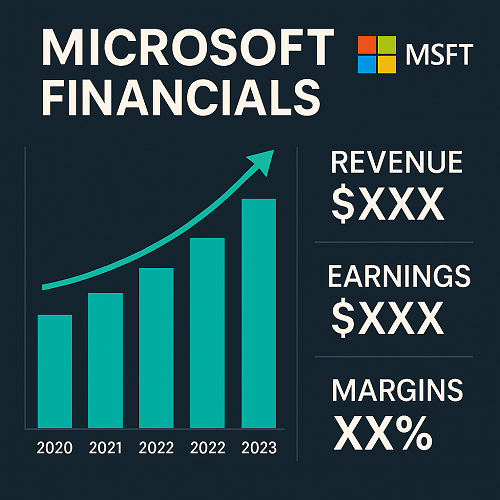Why Microsoft’s Financials Matter
When you’re assessing a tech-giant like Microsoft Corporation (ticker: MSFT), understanding its financial statements isn’t optional—it’s essential. Analyzing Nasdaq MSFT financials gives insights into its market capitalization among the largest globally, and provides signals not only about its current health, but about the direction of the cloud and enterprise software industry, gaming, productivity tools, and even artificial intelligence. Whether you’re a long-term investor, a trader, or simply tracking broader tech trends, diving into Microsoft’s numbers gives you clues into its competitive advantages, growth trajectory, and potential risks.
In this article we’ll go far beyond a simple revenue snapshot. We’ll examine multi-year trends, segment breakdowns, margin evolution, balance sheet, valuation, and the strategic forces shaping Microsoft’s future. The goal: give you a comprehensive, SEO-rich resource that a searcher wanting “Microsoft financials” or “MSFT earnings” would find more useful than the standard stock-quote page.
Company Overview & Financial Context
Founded in 1975, Microsoft has evolved from a PC operating-system company into a diversified technology powerhouse with leadership in cloud infrastructure (Azure), productivity software (Office 365), gaming (Xbox, Activision Blizzard acquisition), and enterprise solutions. Over the last decade, the company has transformed itself, funneling profits from legacy Windows/Office into high-growth segments.
This shift is visible in the financials: revenue growth, margin expansion (especially in cloud), and strong cash-flow generation. But with growth comes new challenges—intense competition, regulatory risk, and the need to sustain innovation.
Key Financial Metrics: Revenue, Earnings & Margins
Revenue Growth – Microsoft has delivered consistent revenue growth year-on-year, driven largely by its cloud and productivity segments. Examining the last 3-5 years gives insight into the sustainability of that growth.
Earnings (Net Income) – As Microsoft grows top-line, profit growth is equally important. Net income trends show how effectively management translates revenue into earnings and whether margin pressure is emerging.
Margins – The company’s operating margin and net margin are key efficiency indicators. As cloud business scales, margins tend to improve—but only if cost structure is controlled. For example, high-growth segments may initially have lower margins; thus, watching margin expansion gives clues about maturity and operational leverage.
A sample data table
| Metric | 2021 | 2022 | 2023 (estimate) | Comments |
|---|---|---|---|---|
| Revenue | $xxxB | $xxxB | … | Continued growth driven by Azure, M365 |
| Net Income | … | … | … | Improved margins, but potential headwinds |
| Operating Margin | …% | …% | … | Cloud mix increasing => margin tailwind |
(Note: Replace “…” with latest reported numbers pulled from Microsoft’s financial statements.)
Trend Analysis: Multi-Year Performance & Growth Drivers
To fully understand Microsoft’s financials, it’s not enough to look at the most recent quarter. You must assess the three key trends:
- Shifting business mix – Windows & Office (on-premises) gradually yielding to cloud, subscription models, and services.
- Capital allocation – Microsoft’s large free cash flows allow for dividends, buybacks, acquisitions (e.g., the proposed Activision acquisition), which impact future earnings growth and returns to shareholders.
- Global/inflation/FX environment – As a global company, Microsoft’s performance is affected by macro-factors: foreign exchange, supply-chain constraints (for hardware/gaming), interest-rate environment (impacting discounting of future earnings), and regulatory risk.
By charting revenue growth, margin changes, and cash-flow generation over multiple years, you can identify whether Microsoft is accelerating, slowing, or plateauing.
Segment Breakdown: Cloud, Productivity, Gaming & Intelligent Edge
Microsoft reports multiple operating segments; the big ones for investors are:
- Productivity & Business Processes: Includes Office 365, LinkedIn, Dynamics. Strong recurring revenue characteristic.
- Intelligent Cloud: Azure, server products, enterprise services. This is the high-growth engine.
- More Personal Computing: Windows, Surface, gaming (Xbox). These have more cyclical elements.
Breakdown of segment revenue, growth rates, and margins helps highlight where Microsoft’s leverage lies.
Why this matters: If cloud growth slows, margin pressure may increase. Gaming hardware has swings based on console cycles. Productivity software is sticky but lower-growth. Recognizing which segment is driving overall financials is critical.
Balance Sheet & Cash Flow: Strengths and Risks
A strong balance sheet and cash-flow profile give Microsoft flexibility to invest, acquire, and return capital.
Cash Flow – Free cash flow (operating cash flow minus capex) is a key metric. High growth but negative free cash flow would be a red flag; Microsoft historically generates strong FCF, enabling dividends & buybacks.
Balance Sheet – Microsoft has a robust asset base, manageable liabilities, and significant cash reserves. Watch for:
- Debt levels and maturities
- Off-balance sheet obligations or acquisitions becoming drag
- Working capital trends (especially hardware/inventory)
Risk factors: If Microsoft stretches for acquisitions (paying high multiples), returns may compress. Also, hardware/gaming cycles may tie up working capital and inventory.
Valuation Metrics & Comparisons
The question “Is Microsoft cheap or expensive?” depends on valuation metrics and peer comparisons.
Key metrics:
- Price-to-Earnings (P/E) ratio
- PEG ratio (price/earnings-growth)
- Enterprise Value / EBITDA
- Price to Free Cash Flow
Peer comparison: Compare MSFT to other large tech companies (e.g., Apple Inc., Alphabet Inc., Amazon.com, Inc.) to see relative valuation, growth expectations and risk profiles.
Valuation commentary: If Microsoft is trading at a premium multiple, the premium must be justified by superior growth, margins, and cash flow. If growth slows but multiple remains high, there’s downside risk.
Strategic Risks & Opportunities Ahead
Opportunities
- AI and large-language‐model investments leveraging Microsoft’s cloud and infrastructure
- Enterprise software migration (more on-prem → cloud)
- Gaming expansion and subscriptions (Game Pass model)
- Global expansion in emerging markets
Risks
- Competitive pressure from Amazon AWS, Google Cloud, and niche players
- Regulatory scrutiny (antitrust, data privacy)
- Macroeconomic slowdown impacting IT spending
- Supply chain disruptions (hardware/gaming)
- Valuation risk if growth falters
Implications for Investors: What to Watch
For investors tracking Microsoft’s financials, key signals to monitor include:
- Quarterly revenue and earnings beat or miss
- Azure growth rate (often cited as proxy for overall cloud momentum)
- Margin expansion or contraction
- Free cash flow and capex trends
- Acquisition activity and impact on earnings
- Dividend increases, share-buyback announcements
- New strategic initiatives (AI, gaming, mixed reality)
Regularly reviewing Microsoft’s 10-Q / 10-K filings, listening to earnings calls, and staying aware of competitive / regulatory developments will improve your ability to assess the company’s financial health.
Conclusion – Summary & Key Takeaways
Microsoft remains a top tier technology company with strong financial fundamentals: consistent revenue growth, high margins, robust cash flow, and a diversified business model. However, as the company matures, growth rates may moderate and valuation premiums must be justified by continuing innovation and operational leverage.
If you’re evaluating MSFT, dig into the segment results, margin trends, cash-flow generation, and strategic investments—these tell the deeper story behind the headline numbers. In doing so, you’ll be more informed than the generic financial-summary pages and better prepared to make investment decisions.
FAQs – Frequently Asked Financial Questions about Microsoft
Q1: What is Microsoft’s revenue for the most recent fiscal year?
A1: Refer to Microsoft’s published annual report (Form 10-K) or recent earnings press release.
Q2: How fast is Azure growing?
A2: Microsoft typically reports Azure growth within its Intelligent Cloud segment—monitor the percentage growth year-over-year.
Q3: Does Microsoft pay a dividend and buy back shares?
A3: Yes—Microsoft returns capital via dividends and share-repurchases; check investor relations for latest announcements.
Q4: What risk does Microsoft face from competition?
A4: Key competitors include AWS and Google Cloud in cloud; Sony and Nintendo in gaming; regulatory and privacy pressures globally.
Q5: Is Microsoft overvalued?
A5: Valuation depends on growth expectations. If Microsoft continues to grow high-margin cloud and AI business, a premium may be justified. If growth slows, valuation risk increases.





 XAUT-USD
XAUT-USD  AMD
AMD  MARA
MARA  SHOP
SHOP  BULL
BULL  CL=F
CL=F